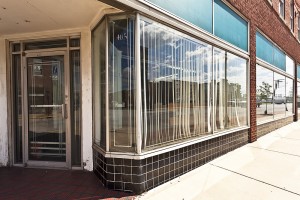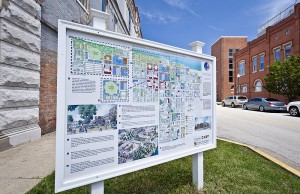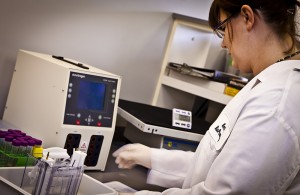Chapter Gallery of Images
What's Done, What's Next: A Civic Pact
Chapter One:
Taking Stock – What Happened in 20 Years
by Keith Schneider
July 13, 2011

The Peirce Report recommended cultivating home-grown businesses that could become major employers, like Kentucky BioProcessing, a leading research firm in plant-based pharmaceuticals.
Just east of the Owensboro-Daviess County Regional Airport, near Carter Road, the white expanse of smooth steel that encloses Kentucky BioProcessing comes into view.
By a number of performance measures considered vital by elected officials, business executives, parents, and especially to young adults thinking of staying or leaving Owensboro, Kentucky Bioprocessing is a model company.
The staff of 35 researchers, engineers, and technicians, more than a third of them educated and trained in Owensboro’s two-year community and four-year colleges, grow genetically-modified tobacco plants under bright lights at a prodigious speed and scale. They also operate the big pressure vessels and stainless steel centrifuges, all hooked together by a maze of pipes and gauges that are leading to new protein purification techniques.
Both the specialty tobacco plants and the advanced processing practices are sought by the world’s pharmaceutical companies, which are racing to produce a new family of plant-based drugs that will shrink tumors, treat cancer, and remedy other diseases. The estimated global market: upwards of $35 billion a year.
Perhaps most importantly to Owensboro, the company was formed locally by Owensboro Medical Health System and is at the hub of what academic, business, and local government officials predict will be a new wheel of industrial fortune for the region. Oh, by the way, employees are paid annual wages that average $55,000 to $60,000, says Hugh A. Haydon, Kentucky BioProcessing’s 52-year-old chairman.
“This business is a clear example of creating your own advantage in a tough economic environment,” said Haydon. “The old operating model of economic development was people follow jobs. Today jobs follow people. We’re leveraging good people, a lot of them raised and educated here in Owensboro, to do some very new things.”
Peirce Report Results
Twenty years ago, in a reporting project funded and published by the Messenger-Inquirer, Neal Peirce and Curtis Johnson produced a remarkably prescient series of articles meant to strengthen Owensboro’s capacity to seize economic opportunity and improve the quality of life in the last decades of the 20th century. Peirce, the dean of American urban affairs journalists, and Johnson, an author, educator and public policy specialist, described a mid-size Kentucky city and farm-based rural county on a bubble, which could expand to soaring success, or shrink to irrelevance.

Peirce Report recommendations included embracing a new culture of entrepreneurism in business, academia, and economic development agencies. James Klauber was recently named president of Owensboro Community & Technical College.
Owensboro of the early 1990s, reported Peirce and Johnson, was a largely white and conservative community clearly comfortable with American economic and social convention. It chased smokestack industries, for instance, and disregarded the value of women as community leaders. A good number of people complained about being isolated, trapped in a low-wage economy. Rates of poverty exceeded the national average and less than one in five adults were college graduates.
Yet Owensboro was also seen as a choice place to live and raise a family. People were friendly, crime was low, the cost of living was moderate. These and other assets, including its Ohio River location, had helped Owensboro become a place that turned out very talented people, like actors Johnny Depp and Florence Henderson.
As they dug into Owensboro, Peirce and Johnson found other intriguing community strengths. Owensboro, for instance, was comfortable with periodically assessing its civic health, and with gathering residents and officials for planning exercises, even if nearly all of them failed to gain any traction in policy or public investment. In other words, said the Peirce Report authors, Owensboro was not hidebound. It had, after all, established a community college, founded barbecue and bluegrass music festivals, and was building the RiverPark Center to anchor the community’s performing arts sector.
Owensboro leaders, moreover, were not content to circle and celebrate their barbeque pits. Aware of how the economy was changing, they were concerned about the future.
Even in the early 1990s, Owensboro’s leaders and residents, reported Peirce and Johnson, were starting to respond to some of the emerging market trends that were pushing other big and small U.S. cities toward a new era of civic health building new educational institutions, redeveloping their waterfronts, constructing new civic spaces for the arts and culture, expanding local festivals into regional and national brands, investing in downtown, and recognizing the threat from sprawling patterns of development.
“There are lots of other potentials,” Peirce and Johnson wrote, “for a community that keeps its antenna up.”
Random Events Real Results

The authors of the Peirce Report recommended that the Owensboro/Daviess County community “face up to a challenging set of shifts” in its civic and economic culture, in order to “make itself a more desirable place to live and ‘hack it’ in the harshly competitive world of the 1990s.”
History, as viewed by most Americans, is one or two straight story lines in which a central character working with a select group of leaders makes the right choices and everything is closed so neatly. In reality, history is more like a slow-moving weather system in which people and institutions are often blown about like leaves in a storm.
In the 1991 Peirce Report, entrepreneurs Bob Green, an energy and transportation industry executive who built the Executive Inn, and Terry Woodward, the founder and chief executive of WaxWorks, were central characters in what Peirce and Johnson saw as Owensboro’s promising shift to a more entrepreneurial economy that encouraged local business growth.
A generation later the 591-room Executive Inn no longer exists. It was demolished in 2009, having succumbed to changes in the market and a succession of management lapses following Bob Green’s death in 1991.

Terry Woodward, a risk-taker and astute business owner, is pursuing new ventures, specifically real estate investment in downtown Owensboro.
WaxWorks is a successful company still, but its music stores and record distribution business were sold to Transworld Entertainment. Video production encompasses much of the company’s business, and its annual revenue of $60 million is a third what it was in the early 1990s.
The Peirce Report, to be sure, understood the influence of random events and the need for Owensboro-Daviess County to establish a more dynamic foundation for making and acting on big ideas. The authors recommended that the Owensboro/Daviess County community “face up to a challenging set of shifts” in its civic and economic culture, in order to “make itself a more desirable place to live and ‘hack it’ in the harshly competitive world of the 1990s.”
Woodward, a risk-taker and astute business owner, instinctively understands that message. He is pursuing new ventures, specifically real estate investment in downtown Owensboro, a market that he is convinced will flourish because of the more than $120 million being invested to redevelop Owensboro’s core. In March earlier this year Woodward paid $1.2 million for the three-story Bates Building at 101 W. Second St., the building next to it and a large vacant lot on Veterans Boulevard that is close to a new riverfront park, and a planned hotel and convention center.
Woodward said his plans include spending $2 million to restore the 17,000 square-foot Bates Building to include six to eight residential units. He wants to develop a five-story mixed-use, retail, and condominium on the vacant lot. “I’m excited that people supported what this city is doing with the riverfront,” Woodward said in an interview. “It benefits all of us. It provides new paths for investment. The reality is we could go further, much further, if we’re willing to.”
Owensboro, meanwhile, took its time to fully absorb the big message of the Peirce Report. Owensboro’s downtown redevelopment project didn’t get started in earnest until the mid-2000s, and federal funding for a new river wall didn’t arrive until 2008. It wasn’t until 2006 that the Greater Owensboro Economic Development Corporation developed a new strategic plan that stressed building entrepreneurship and improving Owensboro as a place to live.
Taking Advantage Grabbing Ready Opportunities

Gateway Planning was hired in 2008 to develop an aggressive master plan that focuses on place-making and downtown revitalization. City and county commissioners in 2009 approved the masterplan and an insurance tax increase to implement the plan.
Of late, though, Owensboro is on a roll. Construction on a new convention center and hotel to replace the Executive Inn is scheduled to start later this year. The proposed 150-room Hampton Inn Suites doesn’t match the Executive Inn’s 591 rooms, but it looks like a good fit for today’s market. A $385 million medical center is under construction east of the bypass. Airport and riverport leaders are developing new plans to more intensively leverage the region’s location at the center of the country, and its existing complement of transport and warehouse companies, as a national shipment and logistics center. New highways are under construction to fully link Owensboro to Interstates 64 and 65.
U.S. Bank Home Mortgage’s processing center at the MidAmerica Airpark is undergoing a $2.8 million expansion that will, along with centers on Highway 54 and South Frederica, lift the number of employees to 1,600 after it’s completed in the fall. Last year, the city and county added 1,100 new jobs, a 2.3 percent increase that led all Kentucky metropolitan areas in job growth.

Owensboro Medical Health System is building a $385 million hospital east of downtown. OMHS was established in 1995 from the merger of two local hospitals. It is now the largest regional employer. Current staff is 3,400; the annual budget will reach $780 million in 2011.
There is good reason for Owensboro to be satisfied with its achievements. But by no means should it be content. The convention and hotel projects, supported by big taxpayer-funded investment, have prompted questions about rising costs, and whether the buildings are big enough or too big for a mid-size market. “We need to answer those questions now, before contracts are signed, ” asserts Karen Miller, the executive director of the Owensboro-Daviess County Convention & Visitors Bureau. “We have one chance to get this right.”
Owensboro Medical Health System’s decision to move from its existing campus, and take over 2,000 jobs with it, has generated lingering doubts about the wisdom of draining that much economic energy from an inner city neighborhood when local governments are simultaneously investing considerable sums to revive the downtown.
Looking Ahead Perils and Possibilities

This fall the city and county schools launch Community Campus, a new curriculum and training program to match high school students with job training and future employment in local businesses, including the lab at Kentucky BioProcessing.
Indeed, Owensboro’s narrative is a story in two parts. First is the host of performance measures that provide unmistakable evidence that in an era of rising energy prices, globalization, intense competition, stagnant incomes, and diminished government resources Owensboro’s work to set a stronger economic and cultural foundation can’t rest.
More than 80 percent of the adults in the region are still not college graduates, though many more have been trained in Owensboro’s two-year college and through various workforce development programs. Median household incomes — $43,000 last year are higher than the Kentucky median income but even with the lower cost of living are still not high enough to provide adequate support for a family. And the number of residents living in poverty 15.2 percent is lower than the state rate but six percent higher than the national average, according to U.S. Census figures.
Owensboro’s city and county populations 57,265 and 96,656 respectively — are growing, albeit at a rate slower than the state and national averages. And diversity is an issue in an age of globalization. More than nine out of ten residents are white. Such homogeneity under five percent of residents are African American, less than three percent are Hispanic, and under one percent are Asian could hurt Owensboro’s competitiveness in encouraging investments from overseas and especially from China, the fastest growing industrial economy in the world.
Another measure of the community’s health is how many talented young people choose to stay in Owensboro and Daviess County to pursue their careers. Almost everyone a visitor meets in town either has a college-educated son or daughter, or knows someone with a high-achieving son or daughter, that couldn’t find a well-paying job in Owensboro.
One reason is that not enough of the small and dynamic companies that attract the interest of young professionals are growing in Daviess County. According to the Greater Owensboro Economic Development Corporation (EDC), so-called “second stage” companies those with 10 to 99 jobs accounted for 0 percent of Daviess County’s new jobs since 2005. In contrast, a quarter of all jobs in the U.S. during the same period came from second stage companies.
Lastly, in an era of deepening austerity in government, five of Daviess County’s top ten employers are public institutions and account for over 4,200 well-paying jobs with benefits. It’s likely that sector will steadily shrink over the next generation. And while most people think about nonprofit employers as separate from public institutions, the emerging and possibly permanent economy will also put a cash collar around organizations like OMHS and River Valley Behavioral Health.
More Nimble Than Most
Still, the second part of Owensboro’s narrative spells real opportunity. In 2006, Expansion Management Magazine’s newsletter for economic development professionals ranked Owensboro as the top community in the country for productivity in transportation, warehousing and distribution. Efficient and reasonably priced transport helped to keep Owensboro’s manufacturers in business. Since 1990, according to the U.S. Bureau of Labor Statistics, Owensboro lost just 5.3 percent of its manufacturing jobs.
Unifirst, one of the nation’s largest suppliers of work uniforms and protective clothing, operates a 320,000-square foot distribution center that employs 300 people at the MidAmerica Airpark, a 450-acre industrial zone that opened in 2005. The airpark also is host to Toyotetsu America Inc.’s $12 million, five-year-old automotive parts plant, Owensboro’s first major Japanese company, which employs 350 people to principally manufacture parts for Toyota.
The Greater Owensboro Economic Development Corporation opened its Centre for Business Research, a high-tech startup incubator, in a renovated and fully equipped 37,000 square-foot warehouse near the center of town. The facility has seven tenants and EDC Executive Vice President Madison Silvert projects that the Centre will have one to three more tenants by the end of 2011.
This fall the city and county schools, with the help of the EDC and the city’s two- and four-year colleges, as well as private employers, launches Community Campus, a new curriculum and training program to match high school students with job training and future employment in local businesses.
Partly as a result of its jobs performance and the city’s growing reputation for innovation, Money Magazine in 2010 ranked Owensboro among the top 100 best small American cities. The Milken Institute named Owensboro one of the 100 “best performing small cities” in its 2010 report. In May 2011, unemployment dropped to 8.4 percent, down from more than 9 percent last year and lower than the state and national jobless rate.
“There is a real sense of urgency here now,” said C. Waitman Taylor, who once was Owensboro’s mayor and now is executive director of The Foundation For Health, a unit of Owensboro Medical Health System. “We aren’t a big city community. We still don’t have a major university. We are a little off the beaten track. But we’re getting pretty good at taking advantage of what we can do here.”
That is almost precisely what the Peirce Report counseled. There are few better examples in Owensboro of the new market principles and civic values that Peirce and Johnson described than Kentucky BioProcessing.

Daviess County’s big farm sector, a perennial state leader in grain production and farm gate value, is a stable industry that could be leveraged for more economic activity.
The plant production and protein synthesis business is home-grown and operating in a huge global market in a sector of the national economy — health care — that also has become dominant in Owensboro. KBP is at the center of what could be a local biotech production industry that could also rely on Daviess County’s big farm sector, and the logistics and transportation industries under development by the city’s airport and riverport leaders. Perhaps most significantly, Kentucky BioProcessing represents the kind of risk-taking investment that the Peirce Report recommended from the city’s strong existing institutions.
That investment, made in 2006, is already producing millions in annual sales and could eventually produce considerably more. Last year the company won a $17.9 million investment award from the Defense Advanced Research Projects Agency, a Pentagon unit, to reproduce therapeutic and immunogenic proteins.
Owensboro Medical Health System, Kentucky BioProcessing’s parent, paid $6 million to Large Scale Biology Corporation for the state-of-the-art 52,000 square-foot building that houses the company. It was a steal. The facility has undergone two expansions at a cost of $16 million and now measures 122,000 square feet. It is still the only indoor plant production center of its kind in the United States, though two others are now under development in Texas and North Carolina.
OMHS also recruited Haydon to run the company. A well-regarded business leader with a distinguished record in the region, Haydon’s resume` includes two stints as director of the Greater Owensboro Economic Development Corp., the region’s primary business development organization. He was president of the Greater Owensboro Chamber of Commerce. And twice Haydon served as a state economic development commissioner.
Kentucky BioProcessing’s staff, which numbered six when the company started, has grown almost six-fold, making it among the fastest growing companies in Owensboro. Under Haydon’s oversight, the company’s staff recruitment program is tied closely to the Owensboro Community & Technical College, which launched a biotech curriculum and training program in 2004. Other sources of talent include the strong science departments at Kentucky Wesleyan College, Brescia University, and the local campus of Western Kentucky University.
Just as importantly, Kentucky BioProcessing’s research program is closely allied to the James Graham Brown Cancer Center at the University of Louisville, a national leader in cancer treatment and pharmaceutical research. In 2007, Owensboro Medical Health System and the University of Louisville formed a partnership that relies on Kentucky BioProcessing to grow the specialized tobacco plants and synthesize the proteins for plant-based drugs developed in Louisville and in the four laboratories that Owensboro Medical Health System established at its own Mitchell Memorial Cancer Center.
Other companies that contract with Kentucky BioProcessing to grow plants and purify proteins for plant-based pharmaceuticals include Bayer AG. “We’re growing,” said Haydon. “We find good people from our local colleges and they are well-prepared. We’re taking advantage of the opportunities this community has developed.”
Chapter Video

The Peirce Report – 20 Years Later
The 1991 Peirce Report made dozens of recommendations for Owensboro and Daviess County citizens and leaders to change the vector of the community’s development. They included embracing a new culture of entrepreneurism in business, academia, and economic development agencies. The idea was to cultivate home-grown businesses that could become major employers.
The report’s authors, Neal Peirce and Curtis Johnson, urged Owensboro to invest heavily to redevelop downtown Owensboro as a livelier place for jobs, housing, and entertainment. They pointed to Daviess County’s big farm sector, a perennial state leader in grain production and farm gate value, as a stable industry that could be leveraged for more economic activity.
The Peirce Report stressed the need to open new channels for women and minorities to take leadership positions in government and business. And it called for the city and county governments to see themselves as managing a region, to operate more collaboratively with each other, and to develop fresh paths for more residents to participate in making big decisions.

The 1991 Peirce Report understood the influence of random events and the need for Owensboro and Daviess County to establish a more dynamic foundation for making and acting on big ideas.
Here is an accounting of Owensboro’s responses to those recommendations:
I. Recommendation: Promote More Regional Collaboration
Result:
- Joint Owensboro Metropolitan Planning Commission is strengthened with city and county funds. Of the agency’s total $1.179 million budget in 2010, the City of Owensboro provided $216,898 and Daviess County provided $143,977.
- City and county fund and oversee 911 emergency response service.
- City and county elected leaders in 2009 approve tax increase on insurance policies to raise nearly $80 million for downtown redevelopment.
- City and county school administrators, in collaboration with Owensboro Community & Technical College and local employers, establish trend-setting Community Campus curriculum and program for high school students.
- City and county fund joint master plan to strengthen management of city and county park systems, and recreation programs.
II. Recommendation: Invest in Downtown Development
Result:
- $17 million RiverPark Center opens in 1992 following $11 million private capital campaign.
- International Bluegrass Music Museum established in 1991 and attracts 24,000 visitors annually.
- $40 million project, much of it federally funded, starts in 2008 to construct river wall, improve Smothers Park, and rebuild Veterans Boulevard.
- Gateway Planning hired in 2008 to develop aggressive master plan that focuses on place-making and downtown revitalization. City and county commissioners approve master plan in 2009.
- City and county commissioners approve a tax increase on personal and business insurance premiums, excluding health insurance, to raise $80 million in public funds to support downtown development.
- Riverfront park, convention center, and hotel under development.
- Executive Inn demolished in 2009, adds 17 acres to riverfront.
- Friday after Five established to attract people to downtown and expose more citizens to the arts center.
- Downtown residential housing starts increase.
- City in 2010 buys State Office Building on Frederica Street for $1.1 million and announces plan to develop a $15 million International Bluegrass Music Center.
III. Recommendation: Stop Chasing Smokestack Industries, Encourage and Sustain Homegrown Employers
Result:
- Owensboro Medical Health System established in 1995 from merger of two local hospitals and grows to largest regional employer and founder of Kentucky BioProcessing. Current staff is 3,400, more than triple hospital employment in 1991. Some 2,500 people work at the Parrish Avenue campus, and 900 others work at regional clinics, diagnostic centers, a business center and the HealthPark. The annual budget reached $780 million in 2011.
- U.S. Bank Home Mortgage, which evolved from George Greenwell’s Lincoln Service Corporation, establishes processing center in MidAmerica Airpark. U.S. Bank’s employment in region anticipated to increase to 1,600 after MidAmerica facility expansion is completed in September 2011.
- Owensboro Community College and Owensboro Technical College merge in 2000; full and part-time staff grows to nearly 500 in 2011.
- Owensboro develops two large baseball/softball complexes, two 10-field soccer complexes, a four-field football complex, a year-round ice arena, tennis courts, park facilities and several gymnasiums. One result is city named by Sports Illustrated as Kentucky’s top sports town in 2004. Playoffs and tournaments draw thousands, anchor the region’s travel and hospitality industry, provide $19 million in direct economic impact to city and county in 2010 and more than half of the $368,459 in city and county room tax receipts.
- MidAmerica Airpark opens in 2005; becomes base for several of region’s largest employers.
- Greater Owensboro Economic Development Corporation approves a new strategic plan in 2006 that focuses on supporting entrepreneurs and innovation as top priorities in supporting new businesses and building the city and regional economies.
- $1 million Emerging Ventures Fund is established in 2007, supported by initial five-year, $100,000 annual grant from city, to support high-growth technology-oriented startups.
- Emerging Ventures Center for Innovation established in 2008 to help entrepreneurs grow startup businesses in Owensboro.
- Owensboro Community & Technical College in 2008 opens first phase of $25 million Advanced Technology Center to train students for jobs in high-tech startups.
- Centre for Business and Research, a 37,000 square-foot renovated warehouse with office space, laboratories, and equipment is completed in 2009 to incubate and grow new home-based companies. Funding provided by Owensboro and Daviess County.

The Peirce Report stressed the need to open new channels for women and minorities to take elected leadership positions in government. Pamela Smith-Wright, Owensboro Mayor Pro Tem, is one of 11 women currently holding elected positions in the city and Daviess County.
IV. Recommendation: Encourage More Women in Leadership Positions
Result:
- Number of women elected to public office increases to 11 from 1.
- Dozens of women occupy non-elected leadership positions in academia, public education, banking, real estate, manufacturing, health care, and recreation.
- Impact 100 Owensboro, a development philanthropy managed by women is formed in 2006 to raise money to “give large grants each fall to local worthy causes selected by the members.”
V. Recommendation: Establish a Community Foundation
Result:
- Green River Area Community Foundation established in 1994; endowment reaches $6.7 million in 2011.
VI. Recommendation: Reach Out to Troubled Families
Result:
- Owensboro-Daviess County Regional Dental clinic established in 2009. Community Foundation is instrumental in recruiting $82,250 in capital funding. Impact 100 in 2010 awards $103,500 grant.
- MacAuley Clinic is center of $25 million in unreimbursed indigent care provided annually by Owensboro Medical Health System.
- City and county public schools ranked among Kentucky’s best though both systems provide free and reduced lunches to more than half of their students.
- Other projects include the Asset Building Coalition to provide free income tax preparation, Bank on Owensboro, the REACH Clinic at the health department, Daviess County Community Access Project, HELP Office, Head Start, and RiverValley Behavioral Health.
VII. Recommendation: Leverage Daviess County Farm Sector to Grow New Businesses
Result:
- The Owensboro Biotech Alliance forms in 2006 to support Kentucky BioProcessing, and to develop stronger links to the University of Kentucky Tobacco Research Development Center. Alliance develops database of regional farmers that enjoy a national reputation for compliance with USDA regulations and a willingness to grow crops for use by plant biotech companies.
VIII. Recommendation: Encourage Greater Public Involvement and Regional Citizenship
Result:
- Greater Owensboro Economic Development Corporation in 2006 launches Economic Development Citizen’s Academy consisting of three two-hour sessions scheduled from January to March. The program is modeled on the successful Citizen Academies developed by the City of Owensboro and the Owensboro Police Department.
- Public Life Foundation of Owensboro founded in 1996 to strengthen citizen engagement in civic decision-making.
IX. Recommendation: Strengthen Educational Institutions and Opportunities.
Result:
- Owensboro High School opens new art and athletic facility in 2010. City and county public schools rank high in Kentucky, and employ nearly 2,600 people.
- Western Kentucky University campus established in Owensboro in 2010.
- College student enrollment in Owensboro grows to 8,000 in 2011.
X. Recommendation: Establish Safe Growth Committee and Rein in Sprawl
Result:
- No committee formed though Owensboro Metropolitan Planning Commission embraces smart growth, downtown-focused principles for containing sprawl and encouraging more walkable land use and development.
- Downtown development plan approved and implemented.
